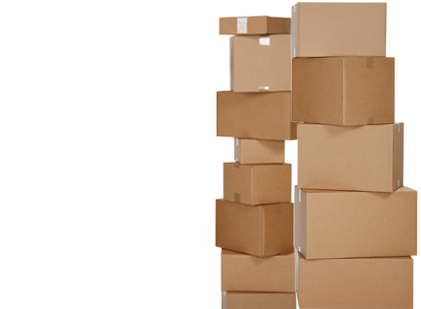 Ensure you have an adequate supply of:
Ensure you have an adequate supply of:
- Tissue paper
- Packing paper (plain newsprint)
- 2″ packing tape
- Permanent markers
- Professional quality boxes (available from Hoover)
- Utility knife and scissors
Quality Boxes
Using new packing materials specifically designed for moving can ensure that your property arrives safely. Hoover has all the boxes and professional packing materials you will need:- 1.5 cu. ft. cartons. Small cartons for heavy items such as books, files, andmusic/video tapes
- 3.0 cu. ft. cartons. Medium utility cartons used for pots and pans, toys, and smallappliances
- 4.5 cu. ft. cartons. For bulky items, such as linens, towels, and toys
- 6.0 cu. ft. cartons. For large, or lightweight articles, such as pillows and largelampshades
- Wardrobe cartons. A tall carton specifically designed to keep your clothes and draperies hanging on a built-in bar
- Mirror cartons. Telescoping cartons for framed pictures, mirrors, and glass
- Mattress cartons. Available in every mattress and box spring size, including crib.
- Dishpacks (China Barrels). Heavy duty cartons used for dishes, china, crystal and glassware
- Double-wall cartons. Extra protective cartons made especially for fine china, crystal,and other high-value, hard to replace items
- Stretchwrap. A special plastic covering that protects your furniture from snags, tears, and dirt
- Poly-vinyl chloride (PVC) packing tape is the most effective tape to seal boxes. Masking tape or narrow cellophane tape should not be used
Packing Preparation
Have all items properly packed and ready for loading the evening before moving day. Leave out only the things you’ll need that night or the next morningBasic Packing Guidelines
- Create a schedule allowing sufficient time leading up to moving day
- Pack items in the basement, garage, and attic first. They are normally items not needed during the moving process
- Packing one room at a time will help you stay organized
- A table to place boxes and items on makes packing easier
- Limit the heaviest cartons to 50 pounds
- Label all items not to be transported on the van
Some Items better handled by the movers
Hoover recommends having their packing team pack the following:- Marble or glass tabletops, heavy wall ornaments, and mirrors 40″ x 60″ or larger
- Pool table
- Bulky, fragile items such as large trophies, statues, chandeliers, etc.
- Major appliances
Additional Suggestions
- Empty drawers of items that are breakable, may spill, or that could puncture ordamage other items
- Keep parts and pairs of items together: curtain rod hangers, mirror bolts, and smallhardware items that should be placed in plastic bags and taped securely to theirarticle
- Pack small, fragile, individually wrapped items separately or together in smallboxes, cushioned with crushed or shredded paper.
- Put a special mark (the number 1, or the letter A) on cartons you want to unpack firstat your destination
- Use newspaper only for cushioning. The ink can rub off and damage finishes.
Items that cannot be packed:
Transport valuable and irreplaceable items with you rather than on the van. Several items cannot be transported on the van: explosives, compressed gases, flammable liquids and solids, oxidizers, poison, corrosives as well as radioactive and other hazardous materials.Examples of items that cannot be moved:
- Nail polish remover
- Paints and paint thinners
- Propane cylinders
- Automotive repair and maintenance chemicals
- Radio-pharmaceuticals
- Matches
- Lighter fluid
- Gasoline
- Fireworks
- Oxygen bottles
- Firearms
- Family photos
- Food in glass jars and perishable foods
- Prescription drugs
- Cash
- Collections (coins, stamps, knives, collectibles)
- Important personal papers (deeds, wills)
- Negotiable papers (bonds, stocks, certificates)
- Jewelry
- Moving documents
The Art of Labeling
Label each carton as follows:- Use a broad, felt-tipped marker
- Clearly mark the contents and room in which it will be placed
- Indicate FRAGILE on delicates and THIS END UP where appropriate
- If available, include Hoovers bill of lading number on each box
- As you finish each carton, list the contents on the side of the carton and in a specialnotebook. You might want to number or code the cartons as well
- Tape a sign on the door of each room at destination corresponding to the carton labels so the movers can quickly place the cartons into the proper rooms
- Place a special mark (the number 1, or the letter A) on cartons you want to unpackfirst at destination.
Practical Packing Tips
- Start with out-of-season items. Next, pack things used infrequently. Leave until thelast minute things you’ll need until moving day.
- Pack similar items together. For example, do not pack delicate china in the samecarton with heavy items
- Wind electrical and other cords
- Wrap items individually in clean paper; use tissue paper, paper towels, or even facialtissue for fine china, crystal, and delicate items. Colored wrapping paper can drawattention to small items that may get lost in a carton. Use double layers of newsprintfor good outer wrapping.
- Place a two to three-inch layer of crushed paper in the bottom of cartons for anadequate safe cushion
- Build up layers, with heaviest items on the bottom, medium-weight next, and lightestitems on top.
- As each layer is completed, fill in spaces firmly with crushed paper, adding additional


